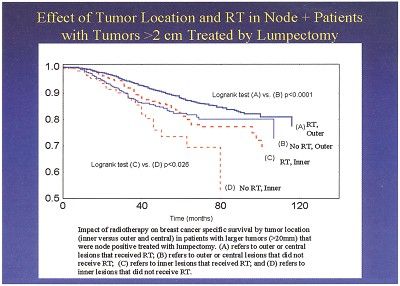Better Prognosis for Outer Quadrant Breast Cancers
SAN FRANCISCO-Survival rates are significantly higher for women who have outer quadrant breast cancer, when compared with patients who have an inner quadrant lesion, according to results presented at the 43rd Annual Meeting of the American Society for Therapeutic Radiology and Oncology (ASTRO abstract 198). At 20 years, the improvement in survival for women with outer quadrant lesions ranged from 2.2% to 9.4%, depending on age group.
SAN FRANCISCOSurvival rates are significantly higher for women who have outer quadrant breast cancer, when compared with patients who have an inner quadrant lesion, according to results presented at the 43rd Annual Meeting of the American Society for Therapeutic Radiology and Oncology (ASTRO abstract 198). At 20 years, the improvement in survival for women with outer quadrant lesions ranged from 2.2% to 9.4%, depending on age group.
These findings confirm the results of three recent studies that have also shown a favorable hazard ratio for outer quadrant disease, said David K. Gaffney, MD, PhD, assistant professor of radiation oncology, Huntsman Cancer Institute, University of Utah, Salt Lake City.
This retrospective study used data from the Surveillance, Epidemiology and End-Results (SEER) registries on 153,368 women with invasive disease diagnosed from 1973 to 1997. Slightly less than two thirds (96,563) had local disease (node negative), while more than one third (56,805) had regional involvement.
Patients were divided into four groups based on age: under 45, 46 to 55, 56 to 65, and 66 and over. The median duration of follow-up was 39 months. Women with inner quadrant involvement were more likely to have local disease (70.8% vs 61.4% for the women with outer quadrant lesions).
Patients with localized disease in all four age groups who had inner and central lesions were less likely to survive (P = .0001 to .0002). For patients with regional disease, only women in the younger-than-45 age group had an increased survival with outer quadrant disease (P = .002). After 20 years, there was a 5.2% increase in survival in this group.
On multivariate analysis for breast-cancer-specific survival, Dr. Gaffney said, the hazard ratio for inner quadrant location, compared with outer quadrant, was 1.40 (95% confidence interval, 1.23-1.60) for local stage, and 1.36 (95% confidence interval, 1.22-1.51) for regional stage (see Figure for data on a specific subset).

"Patients with local and regional stage disease had a significant difference in breast-cancer-specific survival," Dr. Gaffney concluded.
Technological improvements such as PET scanning and lymphoscintigraphy are increasing the ability of radiation oncologists to identify nodal drainage patterns to the internal mammary lymph nodes and, Dr. Gaffney predicts, may lead to improved treatments based on the location of invasive breast cancer.
Newsletter
Stay up to date on recent advances in the multidisciplinary approach to cancer.